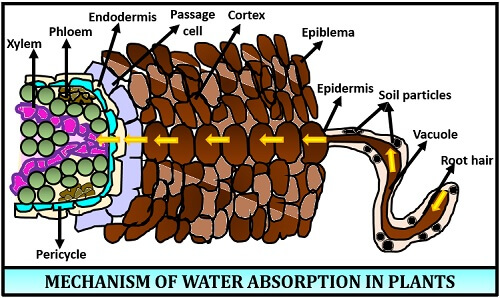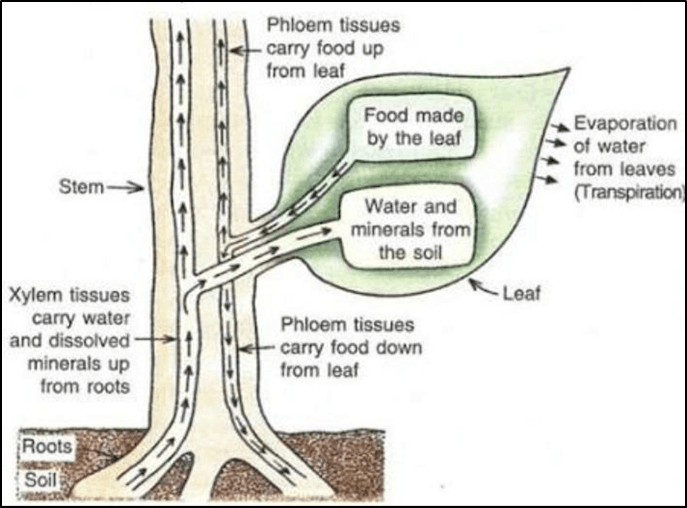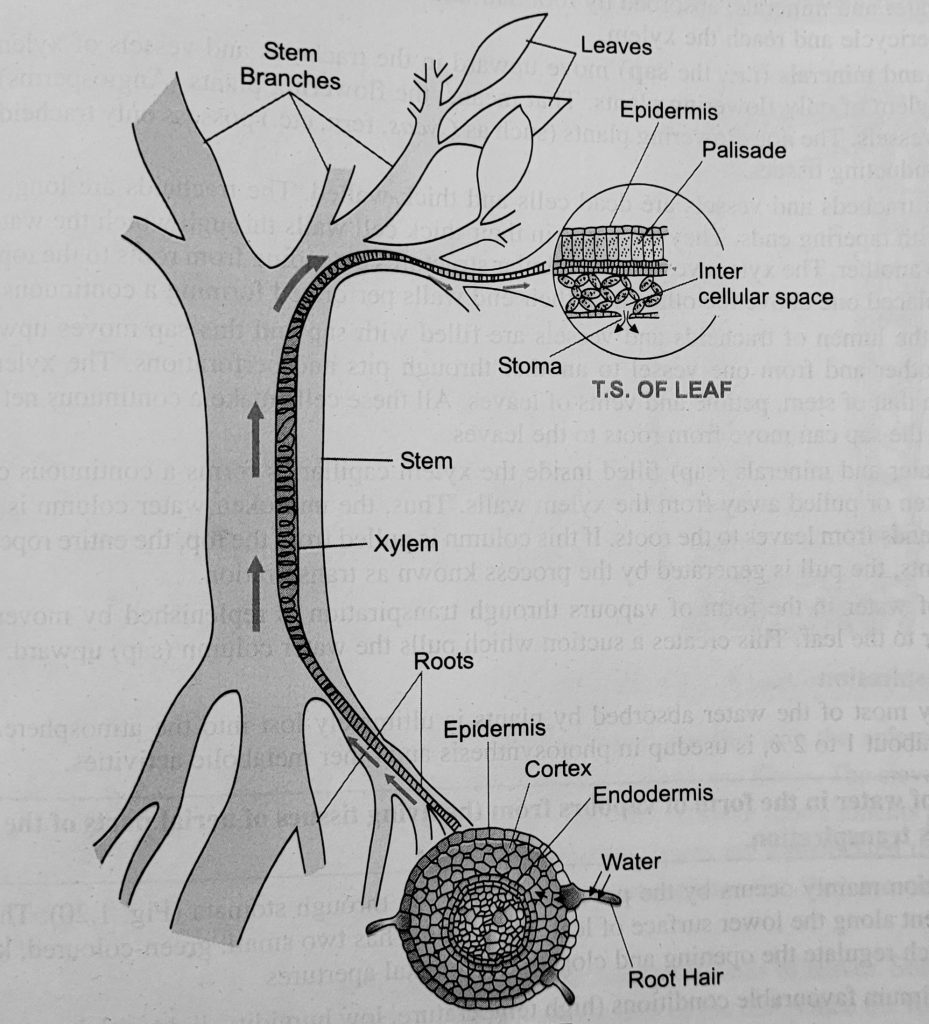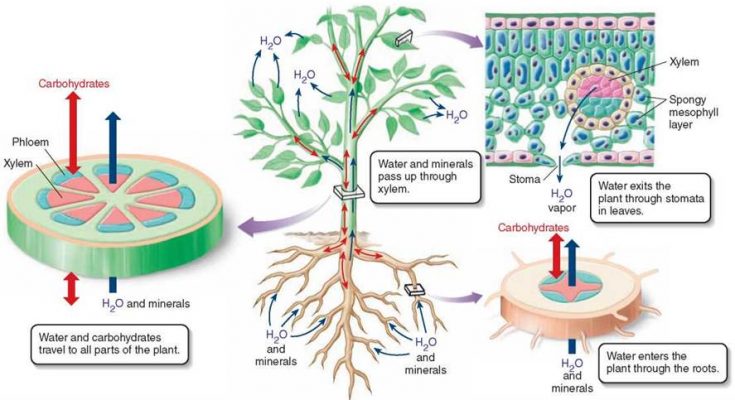Transportation is a life process in which a substance synthesized or absorbed in one part of the organism is carried to other parts of its body.
Table of Contents
How are Water and Minerals Transported in Plants ?
Transportation of Water in Plants

Water and Minerals are essential nutrients that plants need to grow and survive. Water provides the medium for many metabolic reactions in plants, and it also helps to maintain turgor pressure in plant cells, which is necessary for plant growth and structure.
Water Absorption by the Roots

Water is absorbed by the roots through the root hairs.Root Hairs are thin, elongated projections that increase the surface area for Water uptake. Water moves from an area of high concentration (the soil) to an area of low concentration (the root) via osmosis, which is the diffusion of Water molecules across a semipermeable membrane. The Water molecules move from the soil solution into the root hairs due to the difference in Water potential.
Water movement through the Plant via the Xylem
The Xylem is a specialised Tissue that Transports Water and Minerals from the roots to the leaves of a plant. Water moves through the Xylem Tissue due to the physical forces of Transpiration and root pressure. Transpiration is the loss of Water vapour from the leaves of a plant, which creates a negative pressure gradient that pulls Water up from the roots through the Xylem Tissue. Root pressure is a positive pressure gradient that is generated by the roots and can push Water up through the Xylem.
Also Check – Xylem – Definition , Structure, Components (Types), Functions And Importance
Also Check – Functions of the Xylem and Phloem
Physical forces that drive Water movement
- Transpiration is the primary force that drives Water movement through the Xylem Tissue. This process involves the evaporation of Water from the leaves, which creates a negative pressure gradient that pulls Water up through the Xylem.
- Root pressure is another physical force that can aid in Water Transport, especially in small plants. This force is generated by the active Transport of ions into the root cells, which increases the Water potential and drives Water up through the Xylem.
Plant structures that regulate Water Transport
- The stomata are small openings on the surface of the leaves that regulate the exchange of gases and Water vapour between the plant and the atmosphere. They can open and close in response to environmental cues, such as light, temperature and humidity.
- The Casparian strip is a band of Waterproof material that surrounds the endodermis (the innermost layer of the root cortex) and prevents the uncontrolled flow of Water and Minerals into the Xylem. It forces the Water and Minerals to pass through the plasma membrane of the endodermal cells, which can regulate their uptake and Transport.
Also Check – Transportation in Plants
Also Check – Transportation in Human Beings
Transportation Of Minerals In Plants
Minerals, on the other hand, are used by plants to carry out a wide range of biological functions, such as Photosynthesis, Respiration, and the formation of new Plant cells.

How plants acquire essential Minerals from the soil ?
Plants require several essential Minerals for their growth and development, including nitrogen, phosphorus, potassium, calcium, magnesium and sulphur. These Minerals are typically present in the soil as inorganic ions.They are absorbed by the roots through various mechanisms, such as passive diffusion, active Transport and facilitated diffusion. The uptake of Minerals by the roots is influenced by several factors Such as the concentration of Minerals in the soil, the pH of the soil and the presence of competing ions.
Also Check – Phloem – Definition, Structure, Function, Types and How does Phloem tissue work
Mechanisms of Mineral Transport through the plant
Minerals can be Transported through the plant by several mechanisms: –
Passive diffusion- Passive diffusion involves the movement of Minerals from an area of high concentration to an area of low concentration, driven by the concentration gradient.
Active Transport- Active transport on the other hand, requires energy and involves the movement of Minerals against their concentration gradient.
Symplastic Transport -Symplastic Transport involves the movement of Minerals through the cytoplasmic continuum of interconnected cells facilitated by plasmodesmata.
3 Distinct and Interconnected Processes for Transportation of Water and Minerals in plants
The Transportation of water and minerals in plants involves three distinct but interconnected processes –
- Absorption of Water and Minerals
- Ascent of sap or upward movement of Water and Minerals
- Transpiration, i.e., loss of Water in the form of vapours.
Absorption of Water and Minerals
Water Absorption:
- Water is absorbed by land plants from the soil where it is present in the form of soil solution.
- The main water absorbing organs are root hairs.
- Water is absorbed actively by water potential difference between soil solution and root hairs.
- Water molecules move from higher water potential to lower water potential and then migrate from cell to cell passing from epidermis to cortex, from cortex to endodermis and from endodermis to Xylem vessels and tracheids.
- This process is called lateral Transport.
Mineral Absorption:
- Mineral salts move from higher partial pressure to lower partial pressure along the concentration gradient.
- Mineral absorbing organs are root epidermal cells at root apex.
- Mineral salts can be absorbed by passive Absorption or against the concentration gradient by active Absorption.
Ascent of sap or upward movement of Water and Minerals
The ascent of sap is an important process in the Transport of water and minerals in plants.

- The main driving force for the ascent of sap is transpiration, which is the loss of water vapour from the leaves through tiny pores called stomata. Transpiration creates a negative pressure gradient, also known as tension, which pulls water and minerals up through the Xylem vessels.
- The Xylem Tissue consists of hollow, tube-like structures called vessels or tracheids, which are interconnected and form a continuous column throughout the plant. This allows for the efficient Transport of water and minerals from the roots to the leaves.
- The physical properties of water also contribute to the ascent of sap. Water molecules are cohesive, meaning they are attracted to each other, and adhesive, meaning they are attracted to other surfaces. These properties allow water to move up the narrow Xylem vessels through a process known as capillary action.
- The Casparian strip, a specialised layer of cells in the root, helps to regulate the movement of water and minerals from the soil into the Xylem. It prevents the uncontrolled movement of substances into the Xylem, ensuring that only selected materials enter the plant.
- The rate of water uptake and the efficiency of the ascent of sap can be influenced by environmental factors such as temperature, humidity, and light intensity. For example, high temperatures and low humidity can increase the rate of transpiration, leading to faster water uptake and more efficient Transport.
Transpiration, i.e. loss of Water in the form of vapours.
- Transpiration is the process by which plants lose water in the form of vapour from their leaves. This process is driven by a combination of physical forces and plant physiology.
- The main physical force driving transpiration is the difference in water vapour concentration between the inside of the leaf and the atmosphere.
- This difference creates a gradient that causes water to move from areas of higher concentration to areas of lower concentration.
- Plants regulate transpiration in a number of ways to balance water loss with the need to maintain turgor pressure and cool themselves in hot environments.
- One important regulatory mechanism is the opening and closing of stomata, which are tiny pores in the leaves through which water vapour and gases can pass.
Theories to explain the Upward movement of Water
Many theories have been put forward to explain the upward movement of Water.
Two among them are –
- Root pressure theory
- Transpiration pull and Cohesion-Tension Theory.
Root pressure Theory
According to this theory, water is pushed up the Xylem vessels by the pressure created in the roots. This pressure is a result of the active pumping of ions into the root cells, which creates a gradient that draws water from the soil into the root. As water accumulates in the root, it exerts pressure on the Xylem vessels, which pushes the water up the stem. However, this theory cannot explain the upward movement of water in tall trees, as the pressure generated by root pressure is not sufficient to lift water to great heights.
Transpiration pull and Cohesion-Tension Theory
This theory is widely accepted as the main explanation for the upward movement of water in plants. According to this theory, water is pulled up the Xylem vessels from the roots to the leaves by the combined forces of transpiration pull and cohesion-tension. Transpiration pull is created by the loss of water vapour from the leaves through stomata. This loss of water creates a negative pressure, or tension, in the Xylem vessels, which pulls water up from the roots. Cohesion refers to the attraction between water molecules, which allows them to form a continuous column inside the Xylem vessels. The combination of transpiration pull and cohesion-tension creates a continuous flow of water from the roots to the leaves, even in tall trees.
Both theories have some merit and contribute to our understanding of the upward movement of water in plants, but the Transpiration pull and Cohesion-Tension Theory is generally accepted as the main driving force for this process.
Also Check – Why is Transpiration Important for Plants
Also Check – Transpiration in Plants
Role of the Xylem and Phloem in Mineral Transport
- The Xylem is responsible for Transporting Water and Minerals from the roots to the rest of the plant. The movement of Water through the Xylem is mainly driven by Transpiration, which is the loss of Water vapour through the stomata of leaves. As Water evaporates from the leaves, it creates a negative pressure that pulls Water up from the roots and through the Xylem.
- The Xylem also uses active Transport mechanisms to move some Minerals against their concentration gradient. For example – the uptake of potassium ions by plant roots is an active process that is driven by ATP hydrolysis.
- The Phloem is responsible for Transporting sugars, amino acids, and other organic compounds from the leaves to other parts of the plant such as the roots and developing flowers or fruits. This process is called Translocation and is driven by a pressure gradient that is established by the accumulation of organic compounds in source
- Tissues (such as leaves) and their utilisation in sink Tissues (such as roots).
- In addition to organic compounds, some Minerals, such as calcium and magnesium, can also be Transported through the Phloem as complex ions or in association with organic compounds.
Also Check – What are the Differences between the Transport of Materials in Xylem and Phloem?
Also Check – What Is Translocation in Plants for Class 10th
7 Major Events of upward movement of Water and Minerals
- The Water filled in Xylem tracheids and vessels is not pure. It has several Mineral elements dissolved in it. The Minerals needed by plants are absorbed from the soil through root hairs and other epidermal cells of root tip. They are taken up in the inorganic form, such as nitrates, phosphates, etc.
- The Water and Minerals, absorbed by root hair and other epidermal cells, move through root cortex, endodermis, pericycle and reach the Xylem.
- Water and Minerals (i.e., the sap) move upward in the tracheids and vessels of Xylem. Vessels are found in the Xylem of only flowering plants. That means, the flowering plants (Angiosperms) possess both tracheids and vessels. The non-flowering plants (such as Cycas, fern, etc.) possess only tracheids which serve as the main conducting Tissues.
- Xylem tracheids and vessels are dead cells and thick-walled. The tracheids are long, thin, spindle- shaped cells with tapering ends. They have pits in their thick cell walls through which the Water flows from one tracheid to another. The Xylem vessels are tubular structures extending from roots to the top of the plants. The cells are placed one above the other with their end walls perforated forming a continuous tube.
- Thus, the lumen of tracheids and vessels are filled with sap and this sap moves upward from one tracheid to another and from one vessel to another through pits and perforations. The Xylem of the root is connected with that of the stem, petiole and veins of leaves. All these cells make a continuous network of tubes through which the sap can move from roots to the leaves.
- The Water and Minerals (sap) filled inside the Xylem capillaries forms a continuous column which cannot be broken or pulled away from the Xylem walls. Thus, the unbroken Water column is just like steel rope which extends from leaves to the roots. If this column is pulled from the top, the entire rope of sap moves upward. In plants, the pull is generated by the process known as Transpiration.
Also Check – What are the Components of Transport System in Highly Organised Plants
Factors affecting Water and Mineral Transport in plants
Plants are affected by a wide range of environmental and physiological factors that can influence their ability to Transport Water and Minerals efficiently. Some of the most important factors are as follows –
- Temperature- High temperatures can increase the rate of Transpiration leading to greater Water loss from the plant and potentially reducing its ability to Transport Minerals effectively.
- Humidity- Low humidity can also increase Transpiration rates, as the plant loses more Water to the atmosphere. This can reduce the availability of Water and Minerals for the plant.
- Soil type- The physical and chemical properties of the soil can influence the availability of Minerals for plant uptake. For example – acidic soils can make certain Minerals less available, while alkaline soils can cause nutrient deficiencies.
- Plant diseases – Diseases such as root rot can damage the plant’s roots, reducing their ability to absorb Water and Minerals. Similarly leaf diseases can impair Photosynthesis, reducing the plant’s ability to produce the sugars needed for active Transport of Minerals.
- Water availability- In drought conditions plants may struggle to Transport Water and Minerals effectively as there may not be enough Water available in the soil to meet their needs.
- Light intensity- High light intensity can increase the rate of Photosynthesis and sugar production, which can in turn support active Transport of Minerals. However excessive light can also cause damage to the plant’s Tissues reducing their ability to Transport Water and Minerals effectively.
Frequently asked Questions on this Topic
What are the essential nutrients that plants need to grow and survive?
Answer – Water and minerals are essential nutrients that plants need to grow and survive.
What is the role of water in plant growth and structure?
Answer – Water provides the medium for many metabolic reactions in plants and it also helps to maintain turgor pressure in plant cells, which is necessary for plant growth and structure.
What is the role of minerals in plant growth and development?
Answer – Minerals are used by plants to carry out a wide range of biological functions, such as photosynthesis, respiration and the formation of new cells.
How is water transported in plants?
Answer – Water is absorbed by the roots through root hairs and it moves from the soil solution into the root hairs due to the difference in water potential. Water is then transported through the Xylem tissue due to the physical forces of transpiration and root pressure.
What are the physical forces that drive water movement in plants?
Answer – The primary force that drives water movement through the Xylem tissue is transpiration. Root pressure is another physical force that can aid in water transport, especially in small plants.
What are the plant structures that regulate water transport?
Answer – The stomata are small openings on the surface of the leaves that regulate the exchange of gases and water vapor between the plant and the atmosphere. The Casparian strip is a band of waterproof material that surrounds the endodermis and prevents the uncontrolled flow of water and minerals into the Xylem.
How do plants acquire essential minerals from the soil?
Answer – Plants require several essential minerals for their growth and development, including nitrogen, phosphorus, potassium, calcium, magnesium and sulfur. These minerals are typically present in the soil as inorganic ions and they are absorbed by the roots through various mechanisms, such as passive diffusion, active transport and facilitated diffusion.
What are the mechanisms of mineral transport through the plant?
Answer – Minerals can be transported through the plant by several mechanisms, including passive diffusion, active transport and symplastic transport.
What are the three distinct and interconnected processes for transportation of water and minerals in plants?
Answer – The transportation of water and minerals in plants involves three distinct but interconnected processes: absorption of water and minerals, ascent of sap or upward movement of water and minerals and transpiration, i.e., loss of water in the form of vapours.
How is water and mineral absorption accomplished in plants?
Answer – Water is absorbed actively by water potential difference between soil solution and root hairs. Mineral salts move from higher partial pressure to lower partial pressure along the concentration gradient. The mineral-absorbing organs are root epidermal cells at root apex, while the main water-absorbing organs are root hairs.


7 Comments on “How are Water and Minerals Transported in Plants ?”